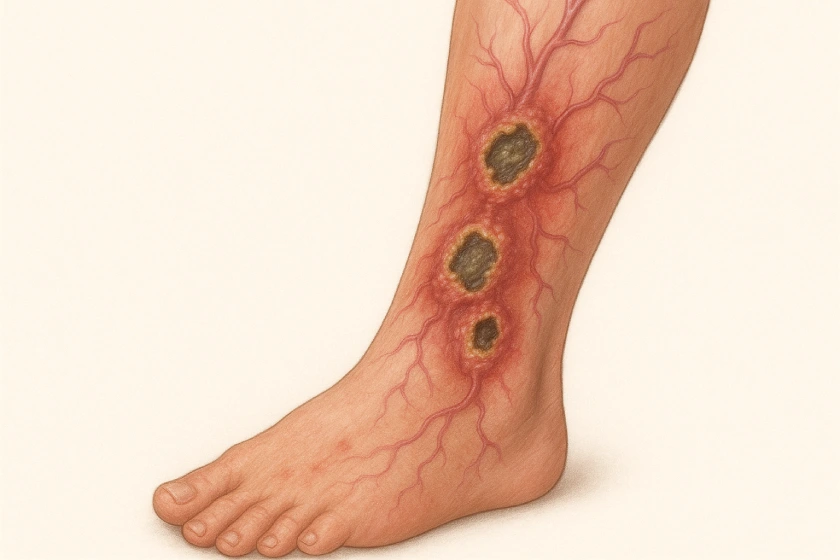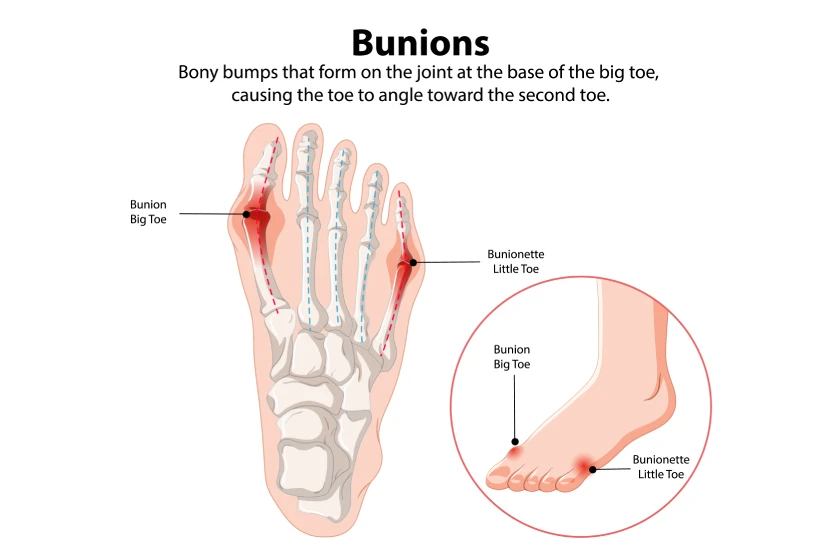What Are Fungal Nail Infections? Causes, Symptoms, and Stages
Our nails often reflect our overall health. When they start turning discoloured, thick, or brittle, it may be more than just a cosmetic issue; it could be a fungal nail infection. A foot nail fungal infection is one of the most common nail conditions, affecting millions worldwide. It develops when fungi invade the nail bed, thriving in warm, moist environments like shoes or locker rooms.
Although it can start small, ignoring the early fungal nail infection symptoms can lead to discomfort, spreading, and even permanent nail damage. Understanding the fungal nail infection causes, symptoms, and stages can help you take timely action and find the right fungal nail infection treatment for long-lasting relief.
What Causes Fungal Nail Infections?
Fungal nail infections (medically known as onychomycosis) occur when microscopic fungi called dermatophytes, yeasts, or moulds infect the nail plate or nail bed. These fungi thrive in warm, humid environments and enter the nail through small cuts or separations between the nail and skin.
Common fungal nail infection causes include:
- Moisture and Sweat: Constant exposure to damp shoes or socks creates the perfect breeding ground for fungi.
- Poor Foot Hygiene: Not drying your feet properly after bathing or exercise can increase infection risk.
- Public Places: Walking barefoot in gyms, pools, or public showers allows fungi to spread easily.
- Injury or Nail Damage: Cracks or breaks in the nail make it easier for fungi to enter.
- Weakened Immunity or Diabetes: People with compromised immunity or diabetes are more prone to foot nail fungal infections.
- Use of Artificial Nails: Acrylic or gel nails can trap moisture, creating an environment for fungal growth.
Understanding these triggers is the first step toward prevention and effective fungal nail infection treatment.
Symptoms of Fungal Nail Infections
Recognising the early signs of a fungal infection is key to successful treatment. Common fungal nail infection symptoms include:
Key services include:
- White, yellow, or brown discolouration on the nail surface
- Thickened or brittle nails that crumble easily
- Foul odour or debris buildup under the nail
- Pain, tenderness, or inflammation around the nail
- Nail separating from the nail bed
- Rough texture or uneven nail edges
A fungal thumb nail infection treatment might differ slightly from foot nail fungal infection care, as fingernails grow faster and are exposed to different conditions. However, both require prompt medical attention to prevent worsening.
Stages of Fungal Nail Infection
Fungal nail infections develop gradually, progressing through distinct stages. Understanding these helps determine the right fungal nail infection treatment and prevent recurrence.
Stage 1: Early Discolouration
You may notice a white or yellow spot under the nail tip. There’s little pain, but the infection is beginning.
What to do: Maintain proper hygiene and seek advice from a fungal nail infection doctor to start topical antifungal medication early.
Stage 2: Thickening and Brittleness
The nail becomes thicker, dull, and brittle. It may start lifting from the nail bed and cause discomfort while walking or wearing shoes.
What to do: Topical creams may no longer suffice; oral antifungal medication or laser therapy might be recommended at a fungal nail infection centre.
Stage 3: Nail Deformation and Pain
At this stage, the infection has penetrated deep into the nail bed, causing visible deformity and pain. The nail may partially detach.
What to do: A visit to a specialised fungal nail infection doctor is crucial. Combined treatment approaches, such as debridement (nail trimming), oral antifungals, and medicated nail lacquers, are typically prescribed.
Stage 4: Severe or Chronic Infection
If untreated, the infection spreads to nearby nails or skin, leading to chronic inflammation and secondary bacterial infections.
What to do: Surgical nail removal or intensive antifungal therapy at a reputable fungal nail infection centre may be necessary. Proper aftercare ensures long-term healing.
When to See a Doctor
Many people delay seeking medical help, assuming the infection will clear up on its own. Unfortunately, that rarely happens. If you notice persistent discolouration, thickening, or pain, consult a fungal nail infection doctor promptly.
You should see a specialist if:
- The infection is spreading or worsening
- You have diabetes or a weak immune system
- Over-the-counter treatments aren’t helping
- You experience discomfort while walking or wearing shoes
A qualified podiatrist or dermatologist can diagnose the condition using nail cultures or microscopic tests and recommend the right fungal nail infection treatment.
Advanced clinics now offer laser therapy and targeted antifungal medications that ensure faster recovery with minimal side effects. If you’re unsure how to treat a fungal nail infection effectively, professional diagnosis is always the safest first step.
Conclusion
Fungal nail infections might seem minor at first, but they can cause significant discomfort and long-term nail damage if left untreated. The good news is that they are both preventable and treatable.
By understanding fungal nail infection causes, recognising early fungal nail infection symptoms, and consulting a trusted fungal nail infection centre, you can regain healthy, clear nails.
Whether it’s fungal thumb nail infection treatment or addressing a foot nail fungal infection, consistency and early medical care are key. From topical antifungal creams and medicated nail lacquers to laser and oral therapies, today’s options make recovery faster and more effective than ever.
If you’re looking for expert guidance on how to treat a fungal nail infection, consult a certified fungal nail infection doctor who can tailor a treatment plan to your condition and lifestyle.Healthy nails are not just about appearance; they’re a sign of well-being. Start your recovery today with the right care and professional support.
FAQs
What are the common symptoms of fungal nail infections?
Common fungal nail infection symptoms include yellow or brown discolouration, thickened or brittle nails, foul odour, and discomfort while walking or wearing shoes.
How does a fungal nail infection progress?
It starts with minor spots or dullness, then thickening and separation from the nail bed. Without fungal nail infection treatment, the infection can spread to nearby nails or skin.
Can fungal nail infections be treated at home?
Mild cases may improve with over-the-counter antifungal creams and good foot hygiene. However, persistent or painful infections should be assessed by a fungal nail infection doctor for proper foot nail fungal infection care.
Who is at higher risk of fungal nail infections?
People with diabetes, poor circulation, weak immunity, or frequent exposure to moist environments are more prone. Wearing tight shoes and walking barefoot in public areas also increases risk.




